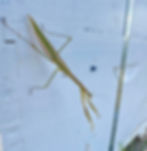One of my absolute favourite topics to teach is the food web - that giant tangle of relationships that keeps our planet alive and buzzing. Everything in nature is connected and all living things need to eat something to stay alive. When I’m visiting kindergartens, schools and community groups, we often end up talking about predators and prey, what different animals need to survive, and the big question:
Who is a friend? Who is a foe? And who is, well… food?
So I wanted to take you on a little tour of some of the creatures who cross paths with my very own bees - from loyal companions to stealthy hunters and of course me!

Spiders: The Free Macca’s Drive-Thru
I keep a few beehives right under my kitchen window, which (unsurprisingly) makes the outside of my window prime spider real estate. For them, it’s like living next to a fast food outlet, where everything that flies by the drive-thru is is fair game.
When I teach children about bees’ jobs, one of the most important roles I mention is the guard bees - the vigilant protectors who hang out at the hive entrance watching for intruders of all sizes, from rival bees to giant humans in white bee-suits like me!.
But spiders don’t walk through the front door; they wait nearby and let the bees come to them. Are spiders friends, foes or food?
From the bee’s perspective: definitely foes.
From the spider’s perspective: lucky neighbours - FOOD!

Chickens: The Helpful Housekeepers
I adore watching my chickens wandering past the hive without a care in the world. They’re completely unfazed by the busy traffic coming in and out.
In fact, my chooks often help tidy up around the hive entrance, pecking at fallen debris — and yes, the occasional dead or dazed bee becomes a cheeky snack (shhh).
Overall, bees and chickens coexist beautifully.
Verdict: Friends… with occasional nibbles.

Dogs: From Bee Whisperers to Drama Queens
This one depends entirely on the dog.
Gus – The Bee Whisperer
Gus, my Australian Bulldog, loves hanging out with the bees. He’ll sun-bake right beside the hive like he’s part of the colony. Not a care in the world.
Tess – Once Bitten, Twice Shy
Tess, my other bulldog, had a very different introduction. Her first sting puffed her face up like she’d gone in for an unplanned Botox appointment. Now she watches the bees from a respectful distance.
Bees are not aggressive towards dogs, but they will sting in defence if a dog swats at them or sticks a curious nose too close.
Verdict: Potential friends — with boundaries.

Ants: Rivals, Relatives and Reluctant House Guests
Ah, ants - a topic of great debate and disdain among beekeepers.
Bees and ants are close relatives, both belonging to the order Hymenoptera, both operating as highly organised superorganisms.
Ants do incredible ecological work:
Decomposition
Soil aeration
Seed dispersal
All of the above helping plants to grow and flowers to bloom, meaning lots of pollen and nectar to gather for bees.
But… they can also invade hives and steal honey when times are tough.
I personally appreciate ants on our farm — especially since they are an important food source for our echidnas.
Verdict: A complicated relationship — part competition, part collaboration.
Praying Mantis: Masters of Stealth (and Snacks)
Praying mantises are fascinating. They sit perfectly still, front legs folded politely as if they’re praying. But don’t be fooled - those legs have spikes designed to pin down prey while it’s eaten alive!
And yes, bees are definitely on the menu.
However, bees have a superpower: safety in numbers. If a mantis snatches a bee, others may launch a coordinated attack - strength through community.
Verdict: Firmly in the “foe… because you eat us” category.
Birds: Fast Flyers & Sting Avoiders
Many insect-eating birds snack on bees, and in Australia the most iconic is the Rainbow Bee-eater. I haven’t seen one myself, but I’ve watched butcher birds and magpies do their thing.
How do they avoid the sting?They catch bees mid-flight, then beat them against a perch to remove the stinger before swallowing. Nature is clever - and a little ruthless.
Verdict: Food. Definitely food.
The Newest Foe: Varroa Mite
Until recently, one creature bees in Australia didn’t have to worry about was the Varroa destructor mite - a tiny reddish parasite that weakens bees and spreads deadly viruses.
But in 2022, varroa arrived at the Port of Newcastle, likely via shipping. After a massive eradication attempt, Australia moved to a transition to management in 2023.
Beekeepers like me are now learning everything we can to protect our colonies from this tiny but destructive foe.
Verdict: A serious and ongoing threat.
So Where Do We Fit In?
There are countless more creatures in the friend–foe–food equation, and the more time I spend observing my bees, the more I appreciate the complexity of the natural world.
After all, I am Friends with Honey - but I’m also a giant apex predator in a spacesuit who occasionally steals the bees’ honey. (With their permission… sort of.)

Want to Explore the Food Web With Me?
If this kind of ecological storytelling fascinates you, I run workshops on:
the food web
biodiversity
pollinators
sustainability
and the incredible interconnectedness of our natural world
I’d love to share this wonder with your school, community group or organisation.




.png)




